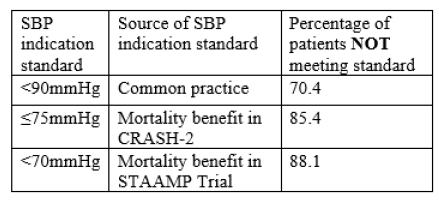Chemoprophylaxis against venous thromboembolism (VTE) is routine in trauma care. In most cases, it can be initiated shortly after admission in most trauma patients. However, there are a few major exceptions, including eye injuries and brain injuries with intracranial hemorrhage.
Solid organ injury used to be cause for concern when considering prophylaxis, but most trauma centers are now comfortable beginning within 24 to 48 hours after injury. Having said that, those numbers are for adult patients. What about the younger ones?
The University of California Irvine group queried the TQIP database (3 recent years) to examine outcomes for adolescent patients (12-17 years old) given VTE prophylaxis after injury to liver, spleen, and/or kidney. They excluded patients who had TBI, anticoagulation or coagulopathy, immediate laparotomy, transfers in, and patients who died or were discharged within 48 hours. They matched patients for age, comorbidities, grade of injury, overall severity of injury, and hypotension/need for transfusion.
Eligible patients who received chemoprophylaxis early (within 48 hours) vs. late were reviewed to identify any differences in complications, length of stay, failed non-op management, and mortality.
Here are the factoids:
- A total of 1,022 cases were isolated from the TQIP database, and 417 adolescent cases were matched to adults
- VTE rate was statistically the same, 0.6% in the early group vs. 1.7% in the delayed group
- Failed non-op management was identical at 5.9% vs. 5.6%
- There was one death in the delayed group and none in the early group (not significant)
- ICU LOS was the same at 3-4 days
- One item not mentioned in the body of the abstract: hospital length of stay was significantly longer in the early group: 9 days vs. 6 days
The authors concluded that early VTE prophylaxis in adolescent trauma patients did not increase failure of nonoperative management, nor did it decrease the incidence of VTE.
Bottom line: This is a study that needed to be done. Due to IRB restrictions, it is typically more challenging to perform actual studies on children and adolescents. Retrospective use of databases helps overcome this problem, although it always introduces a few unwanted wrinkles.
We frequently assume that adolescents behave physiologically like adults. Although often true, you can’t always count on it. Those of us who take care of children and young adults know that they tend to do better than adults by most measures. But again, this is an assumption and needed to be studied.
This database study was limited to three years of data and only produced 417 matched cases for study. This is a small number, and I always worry about statistical power. If the results of such a study are negative, one is left wondering if a proper power analysis was done.
One puzzling result left me wondering about the power question. Patients who received early prophylaxis had exactly the same rate of VTE as those who received it late. Adult data indicates that early use should decrease this complication. Is this another indication of a statistical power problem? Would the inclusion of more patients have shown a real difference?
The other result that struck me (and was not commented upon in the body of the abstract) was the statistically significant 50% increase in hospital length of stay for the early prophylaxis group. Is there some unknown variable that was not matched that caused it? This is one of the known pitfalls of these retrospective database studies.
Here are my questions and comments for the presenter/authors:
- Broken record question: Did you have enough cases to provide adequate statistical power? This study showed a negative result. Did you have enough matched cases to actually be able to detect a difference if there was one? Why not add a few more years of data and recalculate?
- How do you explain the failure of early VTE prophylaxis to protect these patients from DVT or PE? Is this also a statistical power problem?
- Why is the hospital length of stay significantly longer in the early prophylaxis group?
This intriguing paper follows my bias toward treating these patients exactly the same as adults with early chemoprophylaxis. I just need a few of the loose ends tied up.
Reference: SIMILAR RATE OF VENOUS THROMBOEMBOLISM AND FAILURE OF NON-OPERATIVE MANAGEMENT FOR EARLY VERSUS DELAYED VTE CHEMOPROPHYLAXIS IN ADOLESCENT BLUNT SOLID ORGAN INJURIES: A PROPENSITY-MATCHED ANALYSIS. EAST 2023 Podium paper #27.

